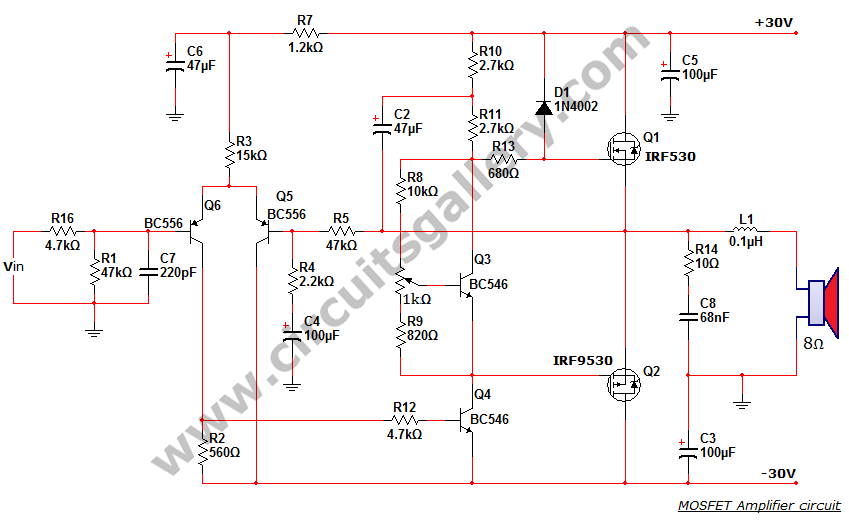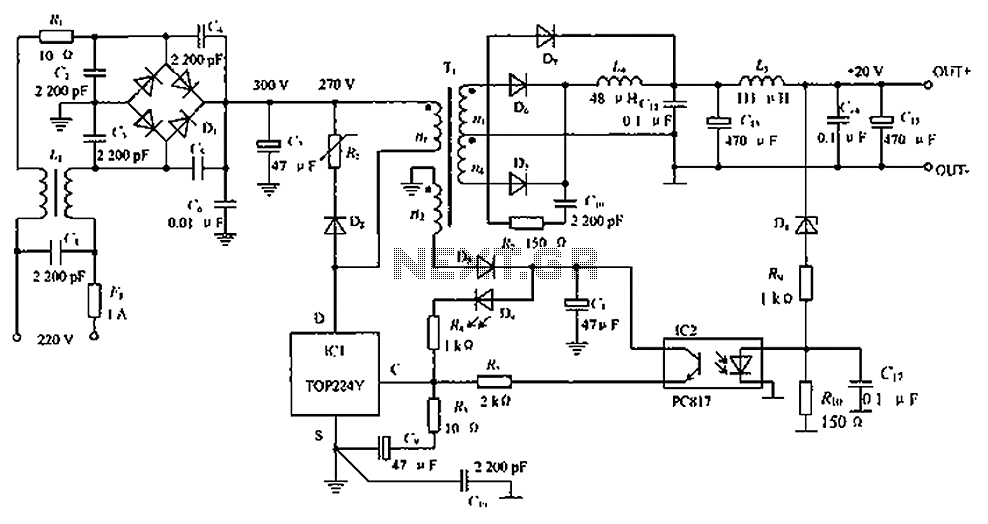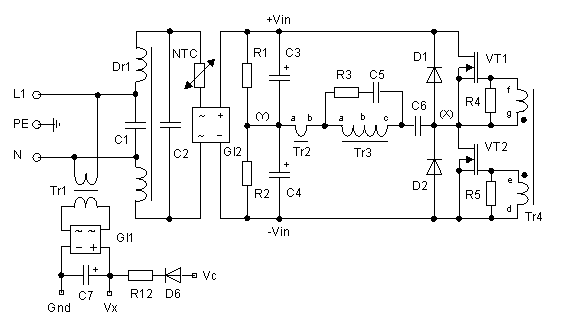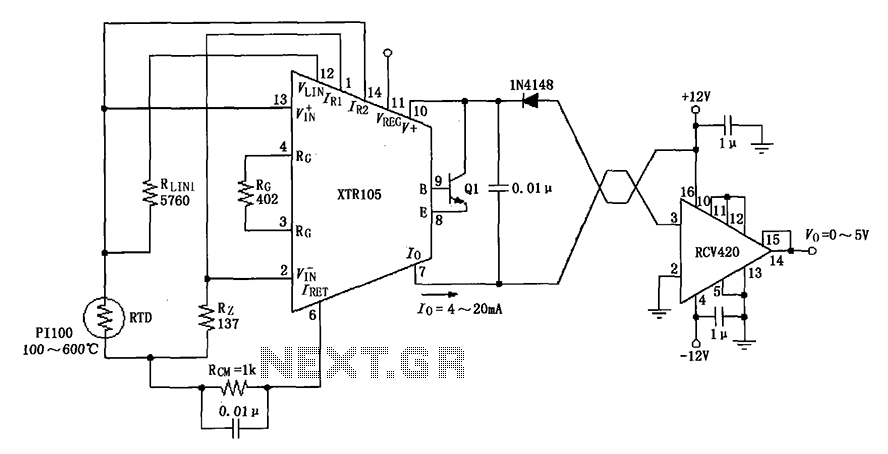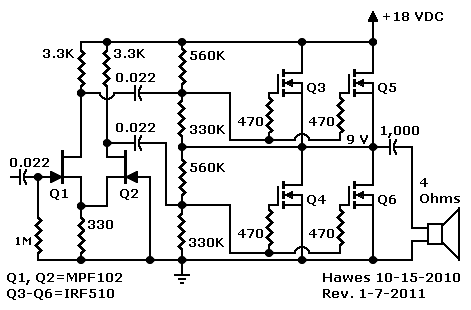
Delay switching for power amplifiers
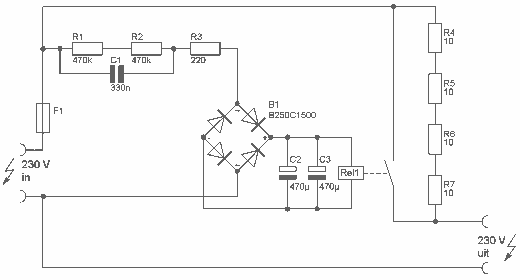
This delay can be used in power amplifiers to prevent the fuses from failing when the amplifier is turned on. The circuit is very simple with a relay that is turned on when C2 and C3 are charged. If the relay has not been applied, the resistors used to control are connected to the feed. If after some time the relay attracts the bridge resistors. Watch out for your own safety when building this circuit. The whole circuit is powered. F1 should be the value of the fuse that would normally be used. More: R1, R2 = 470 kOhm R3 = 220 ? R4-R7 = 10 ? / 5 W wirewound C1 = 330 nF 400 V ~ X2-type C2-C3 = 470 uF 40 - 63V B1 = B250C1500 RE1 = 250 ? 24 V 1200 V / 8 A Contacts F1 = see text
The described delay circuit is primarily utilized in power amplifiers to safeguard against fuse failure during power-up conditions. The core component of this circuit is a relay, which is activated once the capacitors C2 and C3 reach a sufficient charge level. This charging process is critical as it ensures that the relay does not engage until the system is ready, thereby preventing any sudden inrush current that could potentially damage the fuses.
The circuit includes several resistors that play a significant role in controlling the charging rate of the capacitors. Resistors R1 and R2, each rated at 470 kOhm, are likely employed to limit the current flowing into the capacitors, thereby controlling the time it takes for them to charge. Resistor R3, with a value of 220 Ohm, may serve a different purpose, possibly providing a discharge path for the capacitors or influencing the relay's activation threshold.
Resistors R4 to R7, each rated at 10 Ohm and 5 Watts, are wire-wound types that could be used for current sensing or as part of a voltage divider network to monitor the relay's operation. The inclusion of these resistors suggests a design that emphasizes reliability and safety, ensuring that the relay operates under the correct conditions.
Capacitors C1, C2, and C3 are essential for the circuit's operation. C1 is a 330 nF capacitor rated for 400 V, classified as X2-type, which indicates it is suitable for AC applications and can handle voltage spikes. The larger capacitors C2 and C3, each rated at 470 µF and 40-63V, store significant charge to facilitate the relay's operation.
The relay, designated as RE1, is rated for 250 Ohm at 24 V and has contact ratings of 1200 V / 8 A. This indicates that the relay is robust and can handle substantial loads, making it suitable for high-power applications typical in amplifiers.
The fuse, labeled as F1, should be selected based on the specific requirements of the circuit and the power amplifier being used. It is essential to choose a fuse that matches the expected current draw to prevent nuisance blowing while ensuring protection against overload conditions.
Overall, this delay circuit is designed with careful consideration of component ratings and functions, emphasizing safety and reliability in the operation of power amplifiers. Proper attention to the specifications of each component is crucial for the successful implementation of this circuit.This delay can be used in power amplifiers, to prevent the fuses fail when the amplifier is turned on. The circuit is very simple with a relay which turned on when C2 and C3 are charged. If the relay has not been applied, the resistors used to control connected to feed. If after some time the relay attracts the bridge resistors. Watch out for your own safety when building this circuit. On the whole circuit is power. F1 should be the value of having the fuse that normally would be used. R1, R2 = 470 kOhm R3 = 220 ? R4-R7 = 10 ? / 5 W wirewound C1 = 330 nF 400 V ~ X2-type C2-C3 = 470 uF 40 - 63V B1 = B250C1500 RE1 = 250 ? 24 V 1200 V / 8 A Contacts F1 = see text 🔗 External reference
The described delay circuit is primarily utilized in power amplifiers to safeguard against fuse failure during power-up conditions. The core component of this circuit is a relay, which is activated once the capacitors C2 and C3 reach a sufficient charge level. This charging process is critical as it ensures that the relay does not engage until the system is ready, thereby preventing any sudden inrush current that could potentially damage the fuses.
The circuit includes several resistors that play a significant role in controlling the charging rate of the capacitors. Resistors R1 and R2, each rated at 470 kOhm, are likely employed to limit the current flowing into the capacitors, thereby controlling the time it takes for them to charge. Resistor R3, with a value of 220 Ohm, may serve a different purpose, possibly providing a discharge path for the capacitors or influencing the relay's activation threshold.
Resistors R4 to R7, each rated at 10 Ohm and 5 Watts, are wire-wound types that could be used for current sensing or as part of a voltage divider network to monitor the relay's operation. The inclusion of these resistors suggests a design that emphasizes reliability and safety, ensuring that the relay operates under the correct conditions.
Capacitors C1, C2, and C3 are essential for the circuit's operation. C1 is a 330 nF capacitor rated for 400 V, classified as X2-type, which indicates it is suitable for AC applications and can handle voltage spikes. The larger capacitors C2 and C3, each rated at 470 µF and 40-63V, store significant charge to facilitate the relay's operation.
The relay, designated as RE1, is rated for 250 Ohm at 24 V and has contact ratings of 1200 V / 8 A. This indicates that the relay is robust and can handle substantial loads, making it suitable for high-power applications typical in amplifiers.
The fuse, labeled as F1, should be selected based on the specific requirements of the circuit and the power amplifier being used. It is essential to choose a fuse that matches the expected current draw to prevent nuisance blowing while ensuring protection against overload conditions.
Overall, this delay circuit is designed with careful consideration of component ratings and functions, emphasizing safety and reliability in the operation of power amplifiers. Proper attention to the specifications of each component is crucial for the successful implementation of this circuit.This delay can be used in power amplifiers, to prevent the fuses fail when the amplifier is turned on. The circuit is very simple with a relay which turned on when C2 and C3 are charged. If the relay has not been applied, the resistors used to control connected to feed. If after some time the relay attracts the bridge resistors. Watch out for your own safety when building this circuit. On the whole circuit is power. F1 should be the value of having the fuse that normally would be used. R1, R2 = 470 kOhm R3 = 220 ? R4-R7 = 10 ? / 5 W wirewound C1 = 330 nF 400 V ~ X2-type C2-C3 = 470 uF 40 - 63V B1 = B250C1500 RE1 = 250 ? 24 V 1200 V / 8 A Contacts F1 = see text 🔗 External reference

